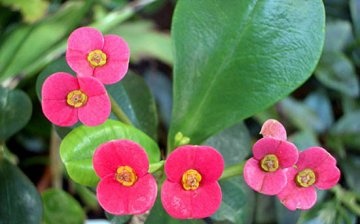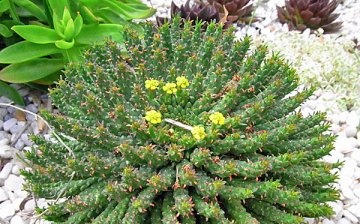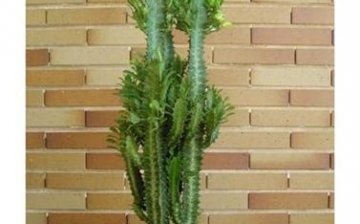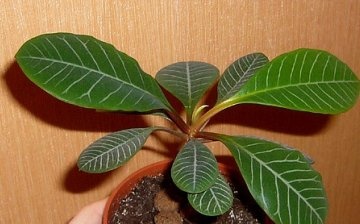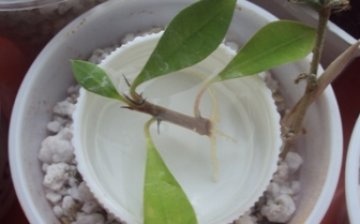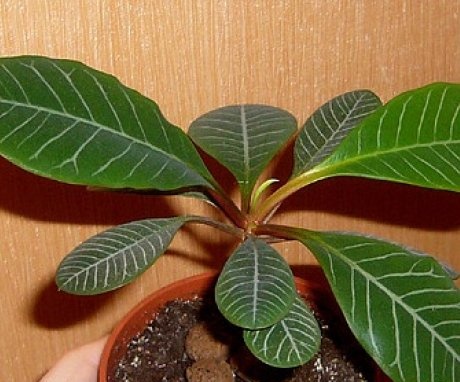Indoor spurge: agricultural technology and plant species
Euphorbia is a perennial that belongs to the Euphorbia family. There are more than 1000 species of this plant, and they grow on almost all continents. Euphorbia is also called Euphorbia, it is a succulent, and the plant got its name from the fact that all plants of this family contain milky sap. Such sap is often poisonous and care should be taken and gloves should be used when caring for such a plant. Many African tribes used the juice of poisonous milkweed, which grows in Africa, for hunting poisonous arrows.
Content:
- Types of indoor milkweed
- Caring for lumpy milkweed
- Reproduction of room milkweed
- The use of room milkweed
Types of indoor milkweed
More than 1000 types of milkweed occurs in the wild, far fewer are grown at home, but there are quite a few of them. Each grower will be able to choose the species he likes.
Separately, we can single out those types of milkweed that are most often grown on windowsills.
Euphorbia Mila:
- This type of milkweed resembles a small shrub, the branches of which are covered with thorns and intertwined with each other.
- Leaves of bright green color are located at the end of the shoot.
- They have an oblong shape and well-defined veins.
- Milkweed flowers also form at the edges of the shoots.
- These small inflorescences will bloom almost all year long if the flowerpot is on a well-lit windowsill. The color of flowers can be pink, yellow or white.
- Under indoor conditions, the height of the shoots reaches 50 cm, and in nature Milkweed bushes meetwhich extend up to 2 m.
- For this plant in the warm season, regular watering is necessary, but in winter it is better to keep the ground a little dry in order to avoid rotting of the roots from severe waterlogging.
- This type of milkweed reproduces with the help of cuttings, less often with seeds.
Trihedral spurge:
- Many amateur gardeners call this type of milkweed a cactus, which is a mistake. As can be seen from the name of this species of milkweed, its trunk has three sides, slightly flattened. If you cut the trunk horizontally, then a triangle will be visible in the section.
- In indoor conditions it grows very quickly, in a few years it grows up to 1.5 m, it easily takes root and grows in almost any conditions.
- There are thorns along the edges of the plant, and green oval-shaped leaves grow on the tops of the shoots.
- Growing out of one triangular trunk, these plants begin to branch in 2-3 years.
- When his height reaches 50-60 cm, he needs to set a stop, since the top becomes heavy, and the weak root system cannot support the entire plant.
- Water and fertilize regularly the plant is necessary in the summer.
- Reproduces very well by cuttings.
Euphorbia white-veined:
- This type of milkweed resembles a palm tree in appearance. The lower part of the trunk is thin, stiff, brown in color, thickens 5-7 cm from the soil. The main trunk is dark green in color and has several ribs. The ribs have red scales that give the plant a velvety look.
- Basically, the spurge is very rarely branched.And if side branches appear, then there are only 2-4 of them.
- The leaves are large, oblong, with pronounced white veins. In the lower part of the trunk, the leaves die off, and as the plant grows, new ones appear at the top, thereby creating dense foliage on the upper part of the plant.
- It blooms with small inconspicuous flowers. In indoor conditions, the trunk can grow up to 1.5 m.
- Needs good lighting and watering. But it is necessary to ensure that the soil dries out, since with regular overflow of the plant, it disappears very quickly.
- Reproduces in indoor conditions on its own.
- After flowering, the plant shoots seeds in different directions.
- When in good soil, young shoots appear after 3 weeks.
Euphorbia Medusa Head:
- This species of milkweed got its name because it looks like the head of Medusa the Gorgon from Greek mythology.
- From a small main trunk, brown in color, many shoots depart, which thicken in the upper part.
- Green shoots outwardly resemble tentacles or snakes that bizarrely bend. It is recommended to grow this type of milkweed in hanging pots, as its branches prefer to hang down, rather than creep along the windowsill.
- Euphorbia jellyfish head is not picky about lighting, grows well both in well-lit places and in partial shade.
- The leaves of this plant are more like scales.
- Flowers are located at the ends of the shoots, blooms in a greenish-yellow color.
- In winter, it is necessary to give the plant rest, and reduce watering to a minimum.
Euphorbia is most beautiful:
- This type of milkweed is more familiar to everyone as a poinsettia or Christmas star.
- For home cultivation, special varieties were bred, the height of which does not exceed 30 cm.
- In nature, this shrub can reach heights of up to 1 m. This type of milkweed is called a Christmas star for several reasons.
- The flowering period is during the winter months.
- And the upper leaves, which are collected in bunches from a small inflorescence and are painted in bright red, white or yellow, resemble a star in their shape.
- The leaves that are located in the lower parts of the branches are green.
- The combination of two colors gives the plant an unusual and festive look.
- This species of milkweed prefers sunny places for growth.
- If the plant does not have enough light, the leaves will not acquire the required color, they will be either pale, or the same color as all other leaves.
- In the summer, the plant needs regular watering as the soil dries out.
- In winter, watering is moderate. Also, this plant needs dry air; with constant dampness, the plant dies.
- The most beautiful euphorbia propagates by cuttings.
- After cutting off the shoot from the main bush, it is necessary to put the cutting in a glass of warm water, when the milky juice comes out, it can be planted for rooting in specially prepared soil.
Caring for lumpy milkweed
Since almost everything milkweed species are succulents, it is worth watering them in moderation. Basically, watering occurs as the soil dries out. Many spurge do not tolerate overflow, this can lead to decay of the plant. In winter, watering should be reduced to a minimum. But you should not allow the soil to dry out too much, especially in species with large leaves.
Euphorbia prefers to be on a well-lit windowsill, but in the summer, during hot weather, plants should be darkened from direct sunlight. It is also recommended to take them out into the open air, without planting them in open ground. For example, on the balcony or in the courtyard of a private house. In winter, it is better to choose a well-lit place for these plants.
Euphorbia does not tolerate low temperatures, therefore, in winter, in the room where the plant is located, the temperature should not drop below +12 degrees.
There are some species that normally tolerate a temperature of +5, but there are only a few of them, the rest are more thermophilic.
Also, spurge do not need regular air humidification, but rather prefer dry warm air around them.
For good development of the plant, it must be regularly fed with mineral fertilizers from spring to late autumn. Very good for fertilizers are suitable for this for cacti. For flowering milkweed, fertilizers for ordinary indoor plants are suitable, only the dosage should be half as much.
It is not recommended to feed the spurge with fertilizers containing nitrogen.
Reproduction of room milkweed
Different types of milkweed can reproduce in different ways: by cuttings, seeds, dividing the rhizome.
When grafting, shoots are cut off, dried for a short period of time:
- This process makes it possible to drain the milky juice from the cutting.
- After such drying, the plant is planted in soft prepared soil before rooting.
- To speed up drying, the cut can be treated with charcoal or put the cutting in warm water for a while.
- However, you should not root the spurge in water, the plants will get drunk with water and after a while will begin to rot without releasing roots.
- Cutting process held in spring or early summer.
Many types of milkweed reproduce well with seeds:
- When sowing seeds into the soil, the first shoots appear after 3-4 weeks.
- And after a few weeks, the plant can already be planted in a separate pot.
The division of the bush is carried out in the spring, when transplanting a plant:
- This type of breeding is also common among many species of milkweed.
- Plants are taken out of the pot, divided into several parts so that at least 3-5 shoots remain on each separated plant.
Annual transplants require only young plant up to 2 years. Mature plants need to be replanted once every 2-3 years.
When transplanting, and especially when grafting, precautions must be taken, since the milky sap of plants has poisonous properties. Therefore, all procedures should be performed with gloves.
The use of room milkweed
Despite the fact that milkweed juice is poisonous, it is very often used as a medicine for treatment of various ailments... For example, the leaves of some species are suitable for preparing decoctions that are used to treat eczema, warts, and various skin lesions.
Also, an alcohol tincture is made from milkweed, which is recommended for use in diseases of the genital organs in men and women.
There are many folk recipes, in which euphorbia is an important component. It is used in the treatment of kidney and liver diseases, pulmonary diseases and diseases of the gastrointestinal tract.
More information can be found in the video.



